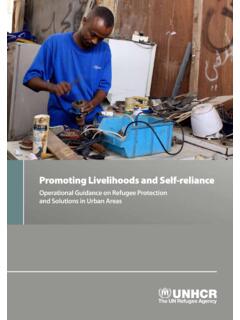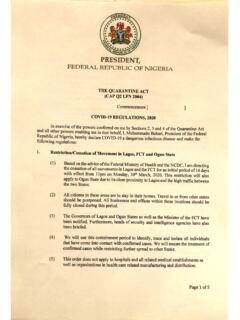Transcription of Qualitative research on women's economic empowerment and ...
1 Qualitative research on women s economic empowerment and social protection A research guide i Qualitative research on women s economic empowerment and social protection A research guide Sara Pavanello, Pamela Pozarny and Ana Paula de la O Campos, Food and Agriculture Organization of the United Nations (FAO) FOOD AND AGRICULTURE ORGANIZATION OF THE UNITED NATIONS Rome, 2015 ii The From Protection to Production (PtoP) programme is, jointly with the United Nations Children s Fund (UNICEF), exploring the linkages and strengthening coordination between social protection, agriculture and rural development. PtoP is funded principally by the United Kingdom Department for International Development (DFID), the Food and Agriculture Organization of the United Nations (FAO) and the European Union. The programme is also part of a larger effort, the transfer Project, together with UNICEF, Save the Children and the University of North Carolina, to support the implementation of impact evaluations of cash transfer programmes in sub-Saharan Africa.
2 For more information, please visit the PtoP website: The designations employed and the presentation of material in this information product do not imply the expression of any opinion whatsoever on the part of the Food and Agriculture Organization of the United Nations (FAO) concerning the legal or development status of any country, territory, city or area or of its authorities, or concerning the delimitation of its frontiers or boundaries. The mention of specific companies or products of manufacturers, whether or not these have been patented, does not imply that these have been endorsed or recommended by FAO in preference to others of a similar nature that are not mentioned. The views expressed in this information product are those of the author(s) and do not necessarily reflect the views or policies of FAO.
3 FAO 2015 FAO encourages the use, reproduction and dissemination of material in this information product. Except where otherwise indicated, material may be copied, downloaded and printed for private study, research and teaching purposes, or for use in non-commercial products or services, provided that appropriate acknowledgement of FAO as the source and copyright holder is given and that FAO s endorsement of users views, products or services is not implied in any way. All requests for translation and adaptation rights, and for resale and other commercial use rights should be made via or addressed to FAO information products are available on the FAO website ( ) and can be purchased through iii Contents Abstract .. iv Abbreviations and v 1. Introduction .. 1 2. Key research hypotheses and questions .. 2 3. Overall research process .. 5 Introduction .. 5 Summary of research process.
4 6 4. Step-by-step research process in each community .. 12 Introduction of research and research team at district level and key informant interviews .. 12 Introduction of research and research team to village head/influential community members .. 12 Community well-being analysis with key informants .. 12 Focus group discussions, key informant interviews and in-depth beneficiary household case studies .. 13 5 research methods and approaches .. 15 Introduction .. 15 General conduct during fieldwork and ethical considerations .. 15 Conducting a focus group discussion .. 17 Recording data from focus group discussions and interviews .. 20 Daily debriefings: summarizing and analysing findings .. 21 6. Question guide .. 26 7. Participatory tools guidelines and examples .. 36 Community well-being analysis .. 36 Access to and control over household resources .. 38 Decision-making matrix.
5 39 Seasonal calendar and gender division of labour and household activities .. 40 Organization and group profiles mapping (Venn diagram) .. 42 Annex A Proposed training schedule .. 44 References .. 46 iv Abstract The FAO s Social Protection and Rural Women s economic empowerment research programme of the Food and Agriculture Organization of the United Nations (FAO) falls under FAO s Strategic Objective 3 of Reducing Rural Poverty and is delivered through two flagship initiatives: the Rural Women s economic empowerment Initiative (RWEE) and the From Protection to Production (PtoP) programme. The research seeks to gain a better understanding of how social protection policies and programmes can be improved to enhance impacts on rural women s empowerment . The programme also aims at identifying ways in which social protection schemes or systems can be strengthened with regard to reducing gender inequalities and improving rural women s economic and social empowerment , actions which can lead to more sustainable pathways out of poverty.
6 A number of case studies will analyse the impact of social protection programmes on rural women s economic empowerment , particularly in two domains: economic advancement and power and agency. The case studies will also assess the impact of programme design on these two domains, as well as the degree to which gender equality and women s empowerment are mainstreamed in programme design and implementation. Finally, to a lesser extent, the programme will assess the synergies that these programmes have with rural services and other livelihoods interventions. Based on previous experience from the PtoP, the case studies are conducted using a mixed- method approach that combines Qualitative and quantitative methods. To achieve comparability and enable cross-country analysis, the research methods are being implemented systematically across countries.
7 This Qualitative research Guide describes in detail the sequencing, timing and methodology of the research process to be implemented in each country of study: training, fieldwork preparation, a simple and clear fieldwork roadmap, the theory of change hypotheses for the studies, guiding questions and research tools. The Guide will be used for conducting Qualitative research as part of this programme and will also serve as a basis for future FAO research on women s empowerment and agriculture. v Abbreviations and acronyms CBO Community-based organization FAO Food and Agriculture Organization FGD Focus group discussion KII Key informant interview MFI Micro-finance institution NGO Non-governmental organization OPM Oxford Policy Management PtoP From Protection to Production programme RWEE Rural Women s economic empowerment Initiative UNICEF United Nations Children s Fund 1 1.
8 Introduction empowerment refers to the process of enhancing the capacity of individuals or groups to make choices and to transform those choices into desired actions and outcomes. The empowerment of rural women is about expanding women s assets and capabilities to participate in, negotiate with, influence, control and hold accountable the institutions that affect their lives. The theoretical framework used in the research programme conducted by the Food and Agriculture Organization of the United Nations (FAO) on rural women s economic empowerment and social protection is based on Golla et al. s framework of women s economic empowerment (2011). The framework considers that a woman is economically empowered when she has both the ability and the power to make and act on economic decisions by: i) succeeding and advancing economically; and ii) having the power and agency to benefit from economic activities.
9 Considering that social protection schemes are often targeted at female-headed households and position women as the primary receivers of transfers, the potential for enabling women s economic empowerment through social protection schemes is significant. FAO s research programme on women s economic empowerment and social protection will conduct a number of case studies to analyse the impact of social protection programmes on rural women s economic empowerment in the two aforementioned domains: economic advancement and power and agency. The case studies will also assess the impact of programme design on these two domains, as well as the degree to which gender equality and women s empowerment are mainstreamed in programme implementation. Finally, to a lesser extent, the research programme will assess the synergies between social protection programmes and rural services and other livelihoods interventions.
10 The case studies use an adaptation of previous methodologies developed for the From Protection to Production (PtoP) programme to evaluate the impact of cash transfers in sub-Saharan Africa. Similarly to the impact evaluation work performed by the PtoP, these case studies use a mixed- method approach which combines Qualitative and quantitative methods. This research Guide on Qualitative Methods is designed as an overall guide for the research teams in the case study countries. The Guide provides an overview of the training, fieldwork preparation including site selection, the theory of change hypotheses for the studies and the research process that will be followed in each case study country. It also introduces the participatory tools to be used to help gather information and provides guidance for conducting key informant interviews (KIIs), facilitating focus group discussions (FGDs) and carrying out in-depth household case studies.











